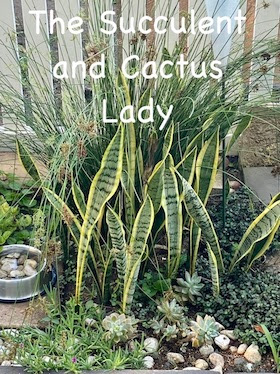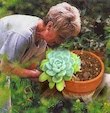(Austrocylindropuntia subulata)
.
Family: Cactaceae
(kak-TAY-see-ee)
Genus: Austrocylindropuntia
(oss-troh-sil-in-droh-PUN-tee-uh)
Species: subulata
(sub-yoo-LAH-tuh)
.
In February 2014, my dear friend
Elizabeth Kendall
sent me a tiny piece of this Eve’s Needle through the post. Unknown to
us, the Post Office was on strike and after a month of being missing in
action, the parcel finally arrived with the poor little Eve’s Needle
definitely looking worse for the wear. I immediately prepared a pot with
some good soil, ample drainage and carefully transplanted her to her
new home. Now, almost 8 months later, she has transformed into a
beautiful specimen, standing almost 40cm (15") tall.
.
Austrocylindropuntia subulata is a large tree-like cactus, up to 13
feet (4 m) tall with round cylindrical joints, up to 2 feet (60 cm) tall
and 1.5 – 2.5 inches (4 – 6.5 cm) thick. The green leaves are nearly
cylindrical, up to 5 inches (13 cm) long. The spines are light yellow, 1
– 2 per areole, up to 3 inches (8 cm) long. The flowers are red, 2 – 4
inches (5 – 10 cm) long, followed by reddish to red fruits up to 4
inches (10 cm) long.
.
This plant is suitable for growing indoors or in containers, is
drought-tolerant and produces beautiful red blooms. Needs regular
watering but be careful not to over-water.
Eve spent a couple of days under cover as we had a lot of rain over the past two days
.
Native to the higher elevations of Ecuador and Peru, this plant was
originally introduced to South Africa for the biological control of
Opuntia ficus-indica, Eve’s Needle has been declared a Category 1 weed
in South Africa as it is a great invader. When the plant gets top-heavy,
pieces break off and take root where they fall, soon forming a dense
wall of cactus killing anything that grows in its path. So I will be
very careful to contain Eve in her pot, trimming regularly and keeping
an eye out for any fallen leaves, needles or little pieces that might
break off.
UPDATE : My Eve's Needle in March 2016, ready to be planted into a suitable spot in the garden where it will be easily controlled so that it doesn't spread as it is regarded as a bit of a pest here in South Africa. I also found this information that The Eve's needle will rarely bloom in
cultivation, but when it does, it produces long, coppery red, showy
blooms. Its fruit is oblong with small spines.
.





4045a.jpg)






